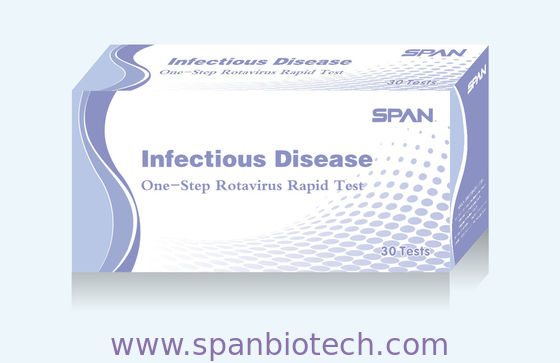|
|
One-Step Rotavirus Ag Rapid Diagnostic Test Uncut Sheet
|
Product Details:
Payment & Shipping Terms:
|
| Specificity: | 100% |
|---|
One-Step Rotavirus Ag Rapid Test
Formats: Uncut Sheets , Bulk Package, 30Tests/Box ,OEM
Specimen:Feces
INTENDED USE
The Rotavirus Rapid Test Device (Feces) is a rapid visual immunoassay for the qualitative presumptive detection of rotavirus in human fecal specimens. This kit is intended to be used as an aid in the diagnosis of rotavirus infection.
INTRODUCTION
Rotavirus is the most common agent responsible for acute gastroenteritis, mainly in young children. Its discovery in 1973 and its association with infantile gastro-enteritis represented a very important advancement in the study of gastro-enteritis not caused by acute bacterial infection. The rotavirus may still be found while diarrhoea continues. Rotaviral gastroenteritis may result in mortality for populations at risk such as infants, the elderly, and immunocompromised patients. In temperate climates, rotavirus infections occur mainly in the winter months. Endemics as well as epidemics affecting some thousand people have been reported. With hospitalised children suffering from acute entric disease up to 50% of the analysed specimen were positive for rotavirus. The viruses replicate in the cell nucleus and tend to be host species specific producing a characteristic cytopathic effect (CPE). Because rotavirus is extremely difficult to culture, it is unusual to use isolation of the virus in diagnosing an infection. Instead, a variety of techniques have been developed to detect rotavirus in feces.
PRINCIPLE
The Rotavirus Rapid Test Device (Feces) has been designed to detect rotavirus through visual interpretation of color development in the internal strip. The membrane was immobilized with anti-rotavirus antibodies on the test region. During the test, the specimen is allowed to react with colored anti-rotavirus antibodies colloidal gold conjugates, which were precoated on the sample pad of the test. The mixture then moves on the membrane by a capillary action, and interact with reagents on the membrane. If there were enough rotavirus in specimens, a colored band will form at the T region of the membrane. Presence of colored band indicates a positive result, while its absence indicates a negative result. Appearance of a colored band at the control region serves as a procedural control. This indicates that proper volume of specimen has been added and membrane wicking has occurred.
KIT COMPONENTS
|
Individually packed test devices |
Each device contains a strip with colored conjugates and reactive reagents pre-spreaded at the corresponding regions. |
|
Specimens collection cards |
For specimens collection use. |
|
Specimens dilution tube with buffer |
Each contains 2 ml of 0.1 M Phosphate buffered saline (PBS) and 0.02% sodium azide. |
|
Disposable pipettes |
For watery specimens collection use. |
|
Package insert |
For operation instruction. |
MATERIALS REQUIRED BUT NOT PROVIDED
|
Timer |
For timing use. |
|
Centrifuge |
For treatment of special specimens. |
PRECAUTIONS
1. For professional in vitro diagnostic use only.
2.Do not use after expiration date indicated on the package. Do not use the test if its foil pouch is damaged. Do not reuse tests.
3.This kit contains products of animal origin. Certified knowledge of the origin and/or sanitary state of the animals does not totally guarantee the absence of transmissible pathogenic agents. It is therefore, recommended that these products be treated as potentially infectious, and handled observing the usual safety precautions (do not ingest or inhale).
4.Avoid cross-contamination of specimens by using a new specimen collection container for each specimen obtained.
5.Read the entire procedure carefully prior to performing any tests.
6.Do not eat, drink or smoke in the area where the specimens and kits are handled. Handle all specimens as if they contain infectious agents. Observe established precautions against microbiological hazards throughout the procedure and follow the standard procedures for proper disposal of specimens. Wear protective clothing such as laboratory coats, disposable gloves and eye protection when specimens are assayed.
7.Buffered Saline contains sodium azide which may react with lead or copper plumbing to form potentially explosive metal azides. When disposing of buffered saline or extracted samples, always flush with copious quantities of water to prevent azide build up.
8.Do not interchange or mix reagents from different lots.
9.Humidity and temperature can adversely affect results.
10.The used testing materials should be discarded in accordance with local, state and/or federal regulations.
Tel: +86(755)89589611
Cell Phone:+8618823462100(WhatsApp)
Web:www.spanbio.com
Contact Person: Ms. Anna Lee
Tel: +86-755-89589611
Fax: 86-755-89580096




